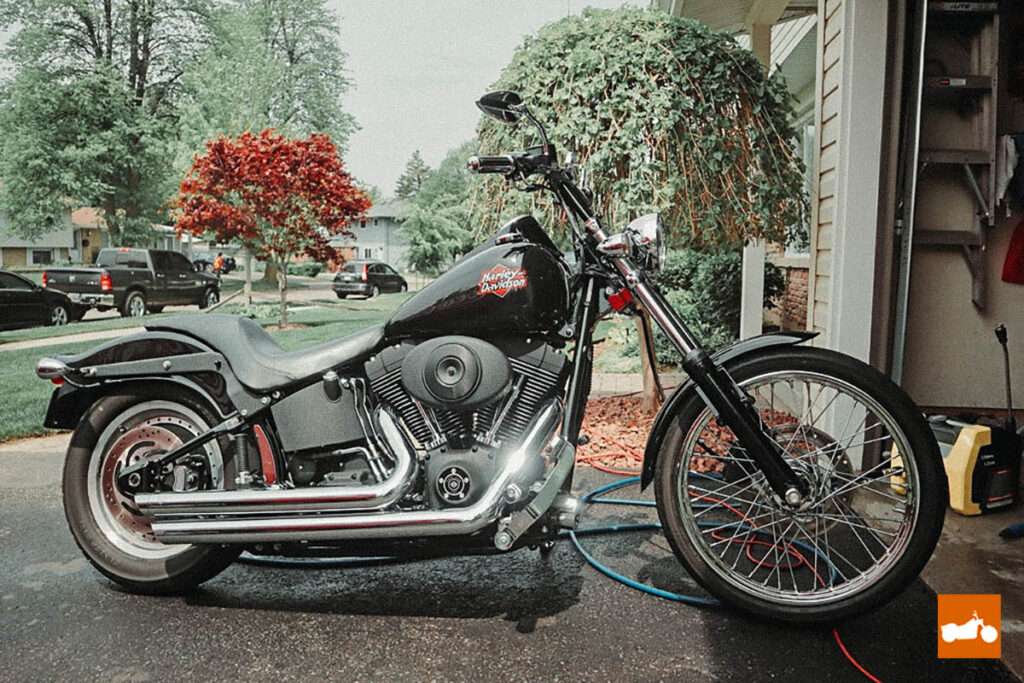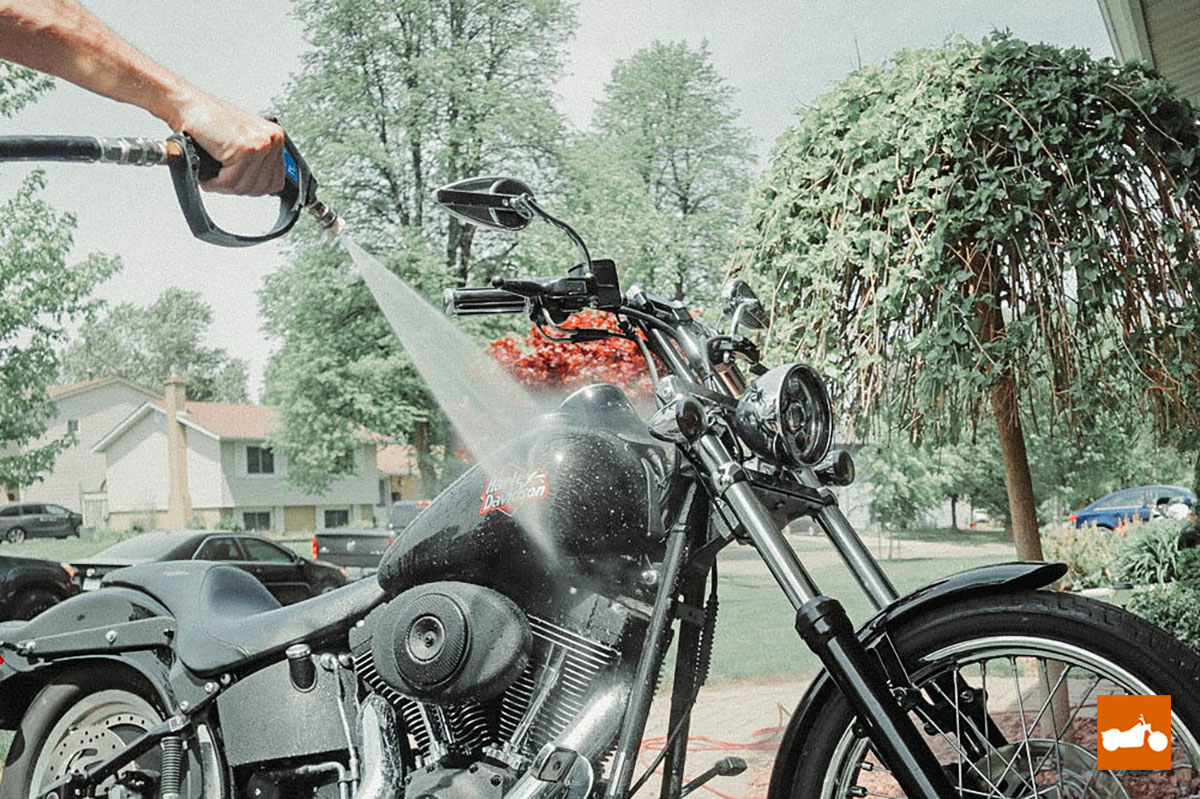Is It Safe To Pressure Wash Your Harley? The Do’s and Don’ts:
One of the best ways to care for your Harley Davidson is to keep it clean. After all, a clean bike is a happy bike, right? Unfortunately, failing to take the proper precautions when washing your bike can actually create problems.
While it is technically safe to pressure wash your Harley, you need to exercise caution and common sense. Unlike cars, motorcycles have many exposed components such as seals, bearings, and electronics. These are water-resistant but pressurized water can still cause damage.
Using a pressure washer and foam cannon on your Harley Davidson
Pressure washing your bike is a very effective way to remove dirt and grime, especially if it’s had a lot of time to build up. Think of this as more of a sledgehammer approach though – you need to be careful and only do it if it’s required.
Being careful when pressure washing your Harley is the name of the game. Yes, it can be done safely if you pay attention to what you’re doing. As a matter of fact, combining the use of a pressure washer and a foam cannon can produce great results in a small amount of time.
It allows you to spray soap onto the surface and into the harder to reach areas near the engine and suspension. Following up with a soft bristle brush to agitate the soap will make quick work of any mild to moderate cleaning. Heavier grime might require using a degreaser and more scrubbing.

Here are some considerations before pressure washing your bike:
Choose the right pressure washer
You shouldn’t need more than roughly 1,000 PSI to effectively clean your motorcycle. Most readily available electric pressure washers will provide enough power to do this.
What soap to use on your bike
You can use any soap that you would use on your car on your bike safely. A good quality ph-neutral soap will give you enough cleaning power while not stripping the wax or sealant from your paint.
Using a dish soap like Dawn on your motorcycle is not a good idea. It tends to leave a residue or film behind which can dry out the surface. It will also strip your wax. To put it simply, dish soap is too aggressive to use on your bike and a product meant for cars should be used instead.
Don’t let the nozzle get too close
This is crucial when it comes to safely pressure washing your motorcycle. Keep your distance! You’re going to want to stay at least 12″ away from your bike if possible. Sure, you might need to get closer to remove a stubborn bug from your gas tank or fender and that’s fine. Just don’t get close to any of the more delicate components (more on those below).
Don’t allow water to stick around after
This is one of the most important things to think about if you’re going to spray your Harley Davidson with a hose or pressure washer. You need to dry it thoroughly after you’re done washing it to make sure there isn’t any standing water left behind.
The best way to accomplish this is with compressed air. You can use different forms of it depending on what you have access to. A vehicle-specific blow dryer like the Air Force Blaster Sidekick works great on motorcycles.

A jet nozzle on an air compressor is another good option for blowing the water out of all the tight spaces of your bike. If you don’t have either of those, a leaf blower will do the job just fine.
Motorcycle components to avoid with a pressure washer:
Unlike the average car, motorcycles have some components that can be pretty delicate. These are things that tend to be hidden under the body of a car, but on a bike, they’re wide open. Here’s a list of things that you should avoid spraying directly with a pressure washer:
- Computer modules
- Wiring
- Handlebar controls
- Gauges
- Wheel bearings
- Spark plugs/wires
- Voltage regulator
- Chain
- Seat (if there are any potential cracks in it)
- Audio systems
All of these components are actually fine to get wet. After all, the manufacturer had to expect there was a possibility of the rider getting caught in the rain. So these components are engineered to be water-resistant.
Pressurized water is a different story though. Spraying these parts directly with just a garden hose on a gentle setting is probably fine. Spraying them with 1,000 PSI however, may allow water to get past seals and into bearings.
What should you not wash a Harley Davidson with?
Now that we know it’s safe to use a pressure washer on your bike, what products or tools should you avoid using?

A gas-powered pressure washer
These units are overkill for any type of vehicle washing in my opinion. There’s no need to be able to crank the pressure up to 3,000 PSI unless you’re cleaning your deck or driveway. An electric one will do the job fine and be much safer.
A sponge
The problem with using a sponge on your paint job is that the dirt and contaminants get trapped between it and your paint. Since sponges don’t have anywhere for the dirt to hide, they end up causing it to roll around between the 2 surfaces – potentially creating scratches.
Using a microfiber towel or wash mitt allows the dirt to get pulled up into the fibers and away from the paint as you wipe. The characteristic of microfiber is to “grab and hold” whereas the sponge just pushes dirt around.
A chamois
Old style chamois should be avoided for the same reason as sponges. Even though you’re drying after washing, there’s still a chance of picking up some dirt left behind. In that case, it’ll be trapped between the paint and the chamois and can create scratches.
The mitt/brushes/towels you use on your car
Aside from the tins (gas tank, fairing, fenders, etc), the rest of your bike should be considered the same as washing the wheels on your car. The engine and suspension are all exposed to whatever your wheels pick up from the ground. These are common areas for things like brake dust, road grime, oil, and grease to be found.
You don’t want to contaminate the wash mitt that you use on your hot rod by scrubbing the engine of your bike. You want to keep this separate – if you want, you can use the tools you use on your car’s wheels on your bike. But just like you wouldn’t use your wheel mitt on your paint, you shouldn’t use the things that touch the dirty parts of your bike either.
Stiff bristle brushes
Soft bristle brushes are your best friend when it comes to getting into the intricate areas of a motorcycle. They are flexible enough to reach the tight spots and soft enough to keep from scratching the finish of the paint, powder coat, or chrome. Stiff bristle brushes do neither of these things. They should be kept for scrubbing things like tires and nothing more.
Tire shine
The final 2 items are considered safety concerns if used improperly. If you don’t feel confident in being able to use them in a safe way, you should avoid them entirely.
The first is tire shine or dressing. When used on the sidewall of the tire, it can be fine. The problem is when you get some on the tread – that’s a recipe for disaster for obvious reasons.
Leather conditioner
Using a leather conditioner on your seat is another thing to be extra careful of. These products (especially the cheaper oil-based ones commonly found at the parts store) will leave your seat greasy and slippery. That’s an important point of contact for you while you’re riding so make sure that whatever you use on your seat is dry to the touch – or use nothing at all.
Washing your Harley at a carwash
Obviously, you aren’t going to ride through an automated carwash (hopefully!) But can you wash your Harley Davidson at a carwash that’s coin-operated?
Using this type of car wash is really no different than using your own electric pressure washer. You need to take all of the same precautions and use extra care but they’re technically safe to use.
The soap that’s offered at these car washes tends to be on the strong side though so you might just want to stick with just a rinse to avoid stripping any wax off your paint. Make sure you avoid using the scrubbing brush on your painted surfaces at all costs – that is a guaranteed way to create scratches.
The biggest downside to washing your bike at a carwash is the lack of compressed air to dry it off properly. The good news is that a lot of the water will be blown off during your ride home. Make sure to follow up with a soft towel afterward if you’re concerned about water spots.
How often should I wash my Harley?
In general, every 2 weeks is a good starting point if you want to stay on top of it. Since there is a minor risk from getting your motorcycle wet, you don’t want to overdo it by washing it too often. How dirty your bike gets heavily depends on the type of riding you do as well as how often you ride.
A bike that gets ridden to work every day regardless of whether it’s raining or sunny outside is going to need to be washed much more often than one that only goes on weekend trips.
The most common contaminates on motorcycles are bug splatters so keep an eye on the front end of the bike. Once you start noticing a lot of bugs stuck to it, it’s probably time for a wash. This applies to fair-weather motorcycles though – bikes that are ridden in wet conditions will get the same type of road grime built up as a car.

Safer alternatives to washing your Harley Davidson
There are some owners that just aren’t comfortable with getting their bikes overly wet. This can be a reason for people to stick with quick wipe downs with detail spray or even not cleaning their bike at all. Neither of these are good options if you care about the condition of your bike.
You can still wash your motorcycle without soaking it with a hose or pressure washer. Rinseless wash products work fantastic when used on bikes. They provide plenty of water for lubrication without spraying it directly at the bike. Products like Optimum No Rinse allow you to safely and quickly wipe your motorcycle down so you can get back out on the road.
Simply fill a bucket with about a gallon of water and mix in a cap full of rinseless wash solution. Throw a few microfiber towels in and proceed to wash the bike one section at a time, flipping to a cleanly folded side of the towel when it gets noticeably dirty. Then, wipe it dry with a separate drying towel.
You can also put some of this mixture (or stronger) in a spray bottle in order to get the bike nice and slick before wiping. This will decrease the chance of scratching the paint even further.
Final word
Washing your bike with a pressure washer can be done safely as long as you stick with the tips in the article. Always use common sense and try to stay focused while you’re working – keep thinking a few steps ahead and always consider whether the component you’re aiming at should be hit with pressurized water.
Using a pressure washer can make removing stubborn bugs and grime a breeze. As long as you keep your distance and avoid the sensitive areas, you should be just fine. It’s always a good idea to start the bike up when you’re done to rattle any standing water away and help it to dry quicker. This can also help water to escape from places that it maybe shouldn’t have reached.

